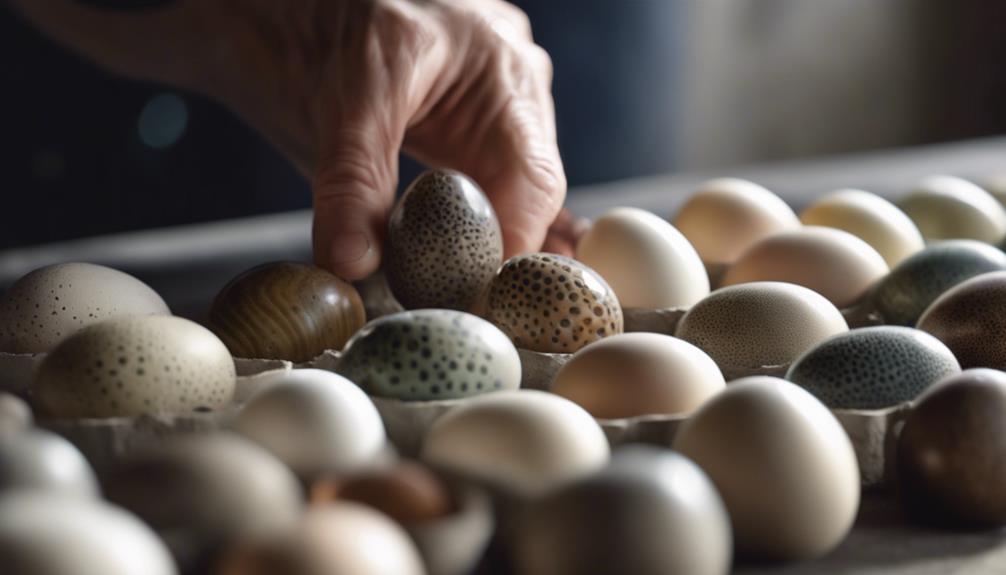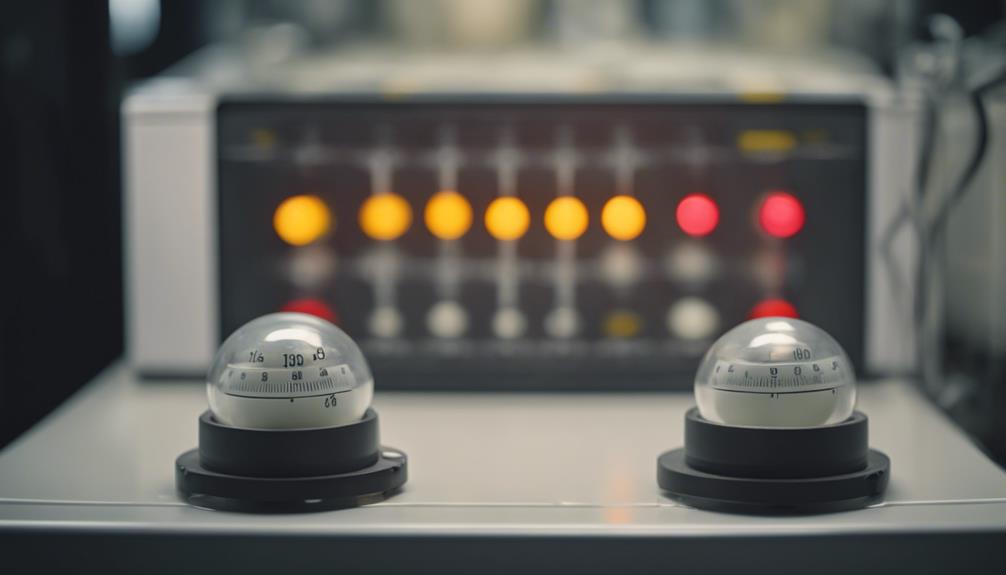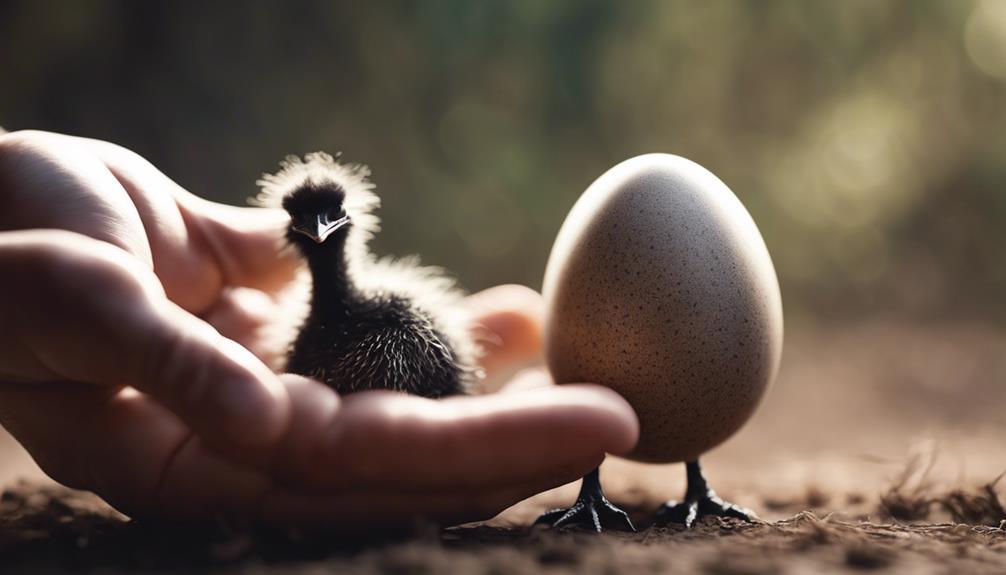
Imagine yourself as a diligent gardener tending to delicate seeds, for successfully incubating emu eggs requires a similar level of care and attention.
As you embark on this journey of nurturing life within a shell, understanding the intricacies of temperature control and humidity levels is just the beginning.
But how do you ensure the conditions are optimal for these unique eggs to hatch successfully?
Let's explore some practical tips that will guide you through the fascinating process of emu egg incubation and hatching.
Key Takeaways
- Monitor temperature, humidity, and ventilation levels consistently.
- Rotate eggs regularly and prepare for hatching conditions.
- Assist in hatching process if necessary for successful outcomes.
- Provide proper care for newly hatched emus to ensure healthy development.
Selecting Healthy Emu Eggs

When selecting healthy Emu eggs, carefully inspect each egg for any cracks or abnormalities before proceeding with the incubation process. Proper egg storage is crucial to maintain the viability of the eggs. Store them in a cool place with a consistent temperature, ideally between 50-60 degrees Fahrenheit, and avoid sudden temperature changes. This helps prevent the eggs from spoiling before they even have a chance to develop.
During the incubation period, it's essential to turn the eggs regularly to ensure even development. Emu eggs should be turned at least three times a day to prevent the embryo from sticking to the shell membrane. This turning mimics the natural process that would occur if the eggs were being incubated by the Emu parent.
Monitoring the development of the embryos is vital to ensure their health. Regularly candle the eggs to check for signs of growth and discard any that show no development. By following these steps, you increase the chances of successfully hatching healthy Emu chicks.
Proper Egg Handling Techniques
To ensure successful Emu egg incubation and hatching, mastering proper egg handling techniques is essential for maintaining the viability and health of the embryos. Begin by sanitizing the eggs carefully before placing them in storage. Use a damp cloth to wipe off any dirt or debris, being cautious not to wash the eggs directly under water as this can compromise their protective coating.
When storing the eggs before incubation, ensure they're kept at a consistent temperature of around 50-60°F (10-15.5°C) in a humid-free environment. Avoid extreme temperature fluctuations as this can harm the developing embryos. Additionally, handle the eggs gently and avoid sudden movements or shaking that could damage the delicate embryos inside.
Remember to always wash your hands thoroughly before handling the eggs to prevent any contamination. By following these egg handling techniques diligently, you're increasing the chances of a successful Emu egg incubation and hatching process.
Setting Up the Incubator Correctly

Properly calibrate the incubator to ensure optimal conditions for the Emu egg's development. Setting up the incubator correctly is crucial for the successful incubation of Emu eggs. To achieve the best results, follow these essential steps:
- Temperature Control: Set the temperature in the incubator to around 97.5 to 98.5 degrees Fahrenheit (36.4 to 36.9 degrees Celsius) for Emu egg incubation. Use a reliable thermometer to monitor and adjust the temperature as needed to maintain consistency throughout the incubation period.
- Humidity Levels: Maintain proper humidity levels within the incubator, aiming for around 25% to 35% relative humidity during the first 40 days of incubation. Increase humidity to 45% to 50% during the final days before hatching. Adequate moisture is vital for the Emu egg's development and successful hatching process.
- Air Circulation: Ensure good air circulation within the incubator to prevent the buildup of carbon dioxide around the eggs. Proper ventilation helps provide the developing Emu embryos with the oxygen they need for healthy growth and development.
Monitoring Temperature and Humidity
For optimal Emu egg incubation and hatching success, ensure diligent monitoring of both temperature and humidity levels throughout the incubation process. Maintaining the correct humidity levels is vital for the health and development of the emu embryos. Humidity levels between 25% and 35% are ideal for the first 45 days, and then they should be increased to 45% to 50% for the final days before hatching.
Fluctuations in temperature can significantly impact the development of the embryos. It's crucial to keep the temperature stable within the range of 97 to 100 degrees Fahrenheit. Sudden temperature fluctuations can lead to developmental issues or even mortality. Invest in a reliable thermometer and hygrometer to accurately monitor these levels regularly.
Egg Rotation Schedule

Maintaining a consistent egg rotation schedule is crucial for ensuring uniform heat distribution and optimal development during the incubation period. Proper egg turning and timing play a vital role in the success of hatching healthy emu chicks. Here are three essential tips to help you master the art of egg rotation:
- Timing is Key: Start rotating the eggs as soon as the incubation process begins. Initially, turn the eggs at least three times a day to prevent the yolks from sticking to the shell membranes.
- Rotating Techniques: Use a marking system to keep track of which side of the egg was last turned upwards. Gentle movements are key; avoid shaking or rough handling to prevent harm to the developing embryo.
- Frequency Matters: As the incubation progresses, increase the frequency of egg rotation to at least five times a day. Consistent and gentle turning ensures that the embryo receives adequate nutrients and oxygen, promoting healthy growth and development.
Importance of Ventilation
Ensuring adequate ventilation throughout the incubation period is crucial for the successful development and hatching of emu eggs. Proper ventilation strategies and air circulation techniques are essential to maintain optimal conditions within the incubator. Here are some key considerations to help you understand the importance of ventilation in emu egg incubation:
| Ventilation Strategies | Air Circulation Techniques |
|---|---|
| 1. Vent holes in the incubator should be adjusted based on the specific needs of the developing emu eggs. | 1. Use of fans to ensure consistent airflow throughout the incubator. |
| 2. Monitor humidity levels to prevent condensation buildup, which can hinder ventilation. | 2. Positioning the eggs in a way that allows for natural air exchange. |
| 3. Regularly clean the incubator to prevent the buildup of dust or debris that could obstruct airflow. | 3. Utilize ventilation slots to promote fresh air intake and carbon dioxide release. |
| 4. Avoid overcrowding the incubator to allow for proper air circulation around each egg. | 4. Consider the impact of external factors like temperature and humidity on ventilation efficiency. |
Understanding Candling Process
To comprehend the candling process thoroughly, illuminate the emu egg with a bright light source to unveil its internal development stages. Candling is a vital technique in monitoring the progress of the embryo inside the egg and ensuring successful hatching. Here are key points to consider:
- Candling benefits: Candling allows you to observe the embryo's growth, detect potential issues early on, and remove infertile or damaged eggs, which can improve overall hatching success.
- Embryo development: Through candling, you can track the development of the embryo, including the formation of blood vessels and air sacs. This insight helps you determine the viability of the egg and make informed decisions throughout the incubation process.
- Candling troubleshooting: Regular candling sessions enable you to identify any irregularities such as unfertilized eggs, early deaths, or malpositions. Addressing these issues promptly can enhance the chances of a successful hatch.
Mastering the art of candling empowers you to nurture your emu eggs effectively, increasing the likelihood of a successful hatching experience.
Dealing With Potential Issues
How can you effectively address potential issues that may arise during the emu egg incubation and hatching process? It's essential to be prepared for any challenges that might come up to ensure the successful hatching of your emu eggs. Two critical aspects to consider are troubleshooting incubator malfunctions and emergency hatching interventions.
Dealing With Potential Issues
Here is a table summarizing how to address these potential problems:
| Potential Issue | Solution |
|---|---|
| Troubleshooting incubator malfunctions | – Check temperature and humidity levels regularly. |
| – Ensure proper ventilation in the incubator. | |
| – Have a backup power source in case of outages. | |
| Emergency hatching interventions | – Monitor the eggs closely for any signs of distress. |
| – Consult a vet or experienced breeder if needed. | |
| – Be prepared to assist the chick in hatching if necessary. |
Preparing for Hatching

Preparation for hatching emu eggs requires meticulous attention to temperature, humidity, and egg turning. To ensure a successful hatching process, follow these essential steps:
- Emu Egg Turning: Emu eggs need to be turned at least three times a day to prevent the embryo from sticking to the shell membrane. Use a pencil to mark one side of the egg and turn it gently from side to side, being careful not to shake the egg too vigorously.
- Hatching Timeline: Emu eggs typically hatch around day 50-54 of incubation. As you approach this timeline, it's crucial to monitor the temperature and humidity levels more frequently. Adjust them if necessary to create the optimal conditions for hatching.
- Prepare the Hatching Area: Set up a safe and warm hatching area for the emu chicks. Ensure that the space is free from drafts and predators. Provide a soft bedding material for the chicks to rest on once they hatch.
Signs of Hatching Readiness
When observing emu eggs for signs of hatching readiness, monitor for subtle movements or vocalizations from within the eggshell. As the incubation time nears completion, you may notice the egg wobbling slightly or hear faint chirping sounds. These are clear indications that the chick inside is preparing to hatch. The hatching behavior of emu eggs is fascinating to witness, as the chicks begin to peck at the shell from the inside. This process can take some time, so patience is key.
Parental involvement is minimal during the hatching process, as emus rely heavily on their natural instincts. The mother emu may stay close to the nest, keeping a watchful eye, but interference should be avoided unless absolutely necessary. Trust in the emu's ability to care for its young and allow nature to take its course. By respecting the hatching process and letting the chicks emerge on their own, you're giving them the best chance at a healthy start to life.
Assisting in Hatching Process

To best support the natural hatching process of emu eggs, refrain from intervening unless there's a clear indication of distress or difficulty. It can be tempting to assist, but interfering too soon can harm the chick inside. However, if you do notice signs of struggle or delayed hatching, there are some techniques you can use to help without causing harm:
- Hatching Assistance Techniques:
- Gently moisten the membrane with warm water to soften it, making it easier for the chick to break through.
- Create a small hole near the air cell to allow for better airflow and help the chick breathe more easily.
- Provide a warm and humid environment to mimic the natural conditions within the egg, aiding the hatching process.
- Emergency Hatching Interventions:
- If the chick is stuck, carefully widen the existing hole to give it more space to emerge.
- Use a damp cloth to carefully remove small bits of shell if necessary.
- Quick Hatch Solutions:
- Increase the incubator temperature slightly to provide extra warmth, which can sometimes encourage hatching.
- Be patient, as hatching can be a slow process, and the chick may just need more time.
Caring for Newly Hatched Emus
Upon hatching, ensure the newly hatched emus are kept warm and dry to support their early development. Emus have specific nutritional needs, so it's crucial to provide them with a balanced diet rich in proteins and essential nutrients. Commercial emu starter feeds are readily available and are formulated to meet the dietary requirements of young emus. Additionally, offering small amounts of finely chopped vegetables and fruits can help supplement their diet and promote healthy growth.
Socialization is key for the well-being of newly hatched emus. Encourage interaction by spending time near the chicks, talking to them softly, and gently stroking them. This helps them get accustomed to human presence and fosters a sense of security. Emus are naturally curious and social birds, so providing them with opportunities to explore their surroundings and interact with other emus or animals can enhance their social skills and overall development.
Frequently Asked Questions
Can Emu Eggs Be Successfully Incubated Alongside Other Types of Bird Eggs, Such as Chicken or Duck Eggs?
You should not incubate emu eggs alongside chicken or duck eggs. Emu eggs require different incubating techniques, temperature regulation, egg turning, and humidity levels compared to other bird eggs. Mixing them could harm the emu eggs.
Is It Possible to Artificially Inseminate Emu Eggs for Incubation, or Do They Need to Be Naturally Fertilized?
Yes, you can artificially inseminate emu eggs for incubation. This method allows for controlled breeding and genetic diversity. Proper storage of emu eggs is crucial to maintain viability before insemination. Understanding the process is key to successful hatching.
How Long Can Emu Eggs Be Stored Before They Are No Longer Viable for Hatching?
You should ideally store emu eggs for up to 7-10 days before their viability decreases. This period allows for successful incubation, ensuring compatibility with the incubation process. Be cautious of longer storage times that may impact hatching success.
Are There Any Specific Dietary Requirements for Emu Parents During the Incubation Period to Ensure Healthy Hatchlings?
During incubation, emu parents need a balanced diet rich in protein and essential nutrients. Their health directly impacts hatchlings' well-being. Ensuring dietary requirements are met enhances incubation compatibility and fosters healthy offspring in mixed species environments.
What Are Some Potential Signs of Distress or Illness in Emu Eggs During the Incubation Process, and How Should They Be Addressed?
Identifying distress signals in emu eggs is crucial. Watch for changes in color, smell, or unusual sounds. Proper handling techniques during incubation include gentle rotations and maintaining consistent temperature and humidity levels. Address any issues promptly for successful hatching.
Conclusion
Now that you've mastered the art of emu egg incubation and hatching, you're ready to welcome your new feathered friends into the world. Remember, patience and attention to detail are key in this delicate process.
With proper care and dedication, you'll soon be surrounded by the adorable sight of newly hatched emus exploring their new surroundings. Embrace the journey of nurturing these unique creatures as they grow and thrive in your care.




